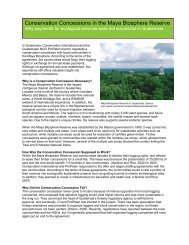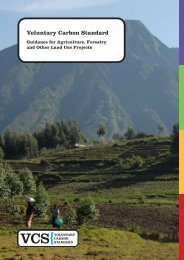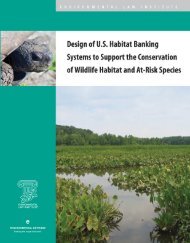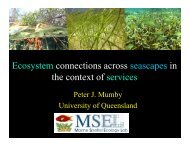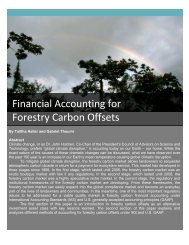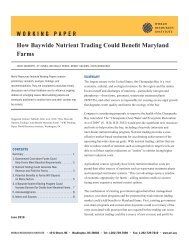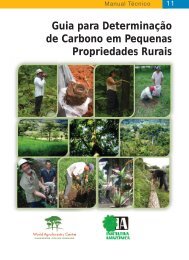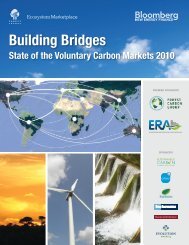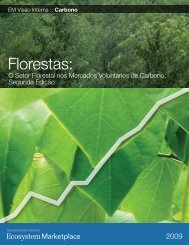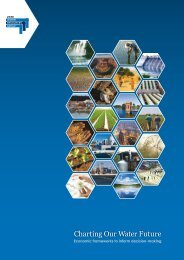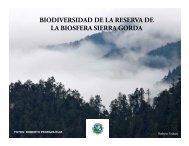Voluntary Carbon Markets by Ecosystem Marketplace
Voluntary Carbon Markets by Ecosystem Marketplace
Voluntary Carbon Markets by Ecosystem Marketplace
You also want an ePaper? Increase the reach of your titles
YUMPU automatically turns print PDFs into web optimized ePapers that Google loves.
<strong>Voluntary</strong> <strong>Carbon</strong> <strong>Markets</strong>
The <strong>Ecosystem</strong> <strong>Marketplace</strong> seeks to become the world’s leading source ofinformation on markets and payment schemes for ecosystem services (servicessuch as water quality, carbon sequestration and biodiversity). We believe that<strong>by</strong> providing reliable information on prices, regulation, science, and othermarket-relevant factors, markets for ecosystem services will one day becomea fundamental part of our economic system, helping give value to environmentalservices that, for too long, have been taken for granted. In providinguseful market information, we hope not only to facilitate transactions, butalso to catalyze new thinking, spur the development of new markets, andachieve effective and equitable nature conservation. The <strong>Ecosystem</strong> <strong>Marketplace</strong>is a project of Forest Trends.www.ecosystemmarketplace.com
<strong>Voluntary</strong> <strong>Carbon</strong> <strong>Markets</strong>An International Business Guide toWhat They Are and How They WorkWritten and edited <strong>by</strong>Ricardo Bayon, Amanda HawnandKatherine HamiltonLondon . Sterling, VA
First published <strong>by</strong> Earthscan in the UK and USA in 2007Copyright # 2007 Bayon, Hawn & Hamilton – Forest TrendsForeword # 2007 Al GoreAll rights reservedISBN: 1-84407-417-X hardback978-1-84407-417-0 hardbackTypesetting <strong>by</strong> 4word Ltd, BristolPrinted and bound in the UK <strong>by</strong> TJ International Ltd, Padstow, CornwallCover design <strong>by</strong> Andrew CorbettFor a full list of publications please contact:Earthscan8–12 Camden High StreetLondon, NW1 0JH, UKTel: þ44 (0)20 7387 8558Fax: þ44 (0)20 7387 8998Email: earthinfo@earthscan.co.ukWeb: www.earthscan.co.uk22883 Quicksilver Drive, Sterling, VA 20166-2012, USAEarthscan is an imprint of James and James (Science Publishers) Ltd and publishes inassociation with the International Institute for Environment and DevelopmentA catalogue record for this book is available from the British LibraryLibrary of Congress Cataloging-in-Publication Data<strong>Voluntary</strong> carbon markets : an international business guide to what they are and howthey work / edited <strong>by</strong> Ricardo Bayon, Amanda Hawn and Katherine Hamilton.p. cmCovers the U.S., Europe, Australia, Canada, and Asia, what the markets are, how theywork, and their business potential to help slow climate change.Includes index.ISBN-13: 978-1-84407-417-4 (hardback)ISBN-10: 1-84407-417-X (hardback)1. Emissions trading. 2. Environmental impact charges. 3. <strong>Carbon</strong> dioxide mitigation–Economic aspects. 4. Greenhouse gases–Economic aspects. 5. Climatic changes–Economic aspects. I. Bayon, Ricardo. II. Hawn, Amanda. III. Hamilton, Katherine.HC79.P55V65 2006363.738 0 746–dc22 2006029027The paper used for the text pages of this book is FSC certified.FSC (The Forest Stewardship Council) is an international networkto promote responsible management of the world’s forests.The <strong>Ecosystem</strong> <strong>Marketplace</strong> will offset greenhouse gas emissionsdirectly resulting from the publication of this book.Printed on totally chlorine-free paper
ContentsList of Figures, Tables and BoxesList of ContributorsAcknowledgementsForeword <strong>by</strong> Al GoreList of Acronyms and AbbreviationsIntroductionviiixxiixivxvixviii1 The Big Picture 1Market theory 3<strong>Carbon</strong> markets 4<strong>Voluntary</strong> carbon market 112 Understanding Supply and Demand in the <strong>Voluntary</strong><strong>Carbon</strong> MarketA look at the supply chain 18How does the market work? 293 How Does the <strong>Voluntary</strong> <strong>Carbon</strong> Market Relate to theUS REC Market? 38Walker L. WrightWhat are RECs? 39The voluntary market 41Certify it 44Market trends 45RECs and the voluntary carbon market 46What the experts think 48Renewable Energy Certificates to carbon offsets: What’sthe right exchange rate? (Mark Trexler) 48Renewable Energy Certificates and carbon offsets: What informedcustomers need to know (Robert Harmon) 50Clearing the air: the impact of carbon cap-and-traderegulations on the voluntary market for renewable energy(Robert Harmon) 53
List of Figures, Tables and BoxesFigures1.1 The greenhouse effect 21.2 Growth in the global carbon market 72.1 Simplified supply chain of the retail carbon market 182.2 A model of common types of transactions in the voluntarycarbon market 292.3 A quick sketch of the different kinds of buyers in the voluntarycarbon market 313.1 A map of the RPS standards in the United States 403.2 Current input-based cap-and-trade system 563.3 Current system with 500GWh gas added 563.4 Current system with 500GWh wind added 573.5 Output-based system with 500GWh natural gas added 583.6 Output-based system with 500GWh of wind added 593.7 Load-based cap-and-trade 603.8 Load-based cap-and-trade with 500GWh of wind added 614.1 US GHG emissions 65A1.1 Commonly used emission reduction and sequestration projects 108Tables1.1 <strong>Voluntary</strong> carbon market size 142.1 Project types generating carbon credits for the voluntary carbonmarket 202.2 Major certification programmes/standards available or soon tobe available for the voluntary carbon offset market 232.3 Global sources of pressure in the private sector 332.4 Regional sources of pressure in the private sector:Europe 332.5 Regional sources of pressure in the private sector:North America 333.1 REC sales in voluntary markets 42
viii<strong>Voluntary</strong> <strong>Carbon</strong> <strong>Markets</strong>3.2 Certified REC customers and sales for leading voluntary certifierGreen-e 423.3 Utility use of RECs to supply green pricing programmes 433.4 Comparison of alternative application systems 62A2.1 Examples of project verifiers 116A4.1 Examples of offset credit retailers 125A5.1 Examples of institutional buyers 152Boxes1.1 A look at the science 11.2 The Chicago Climate Exchange (CCX) 52.1 The additionality debate 244.1 Case Study: Mantadia-Zahamena corridor restoration andprotection project, Republic of Madagasca 70
List of ContributorsDr David Brand is the founder and Managing Director of New Forests, aforestry asset management and advisory business based in Sydney, Australia(see www.newforests.com.au). The firm represents institutional and privateequity investors in forestry and land management, specializing in investmentprogrammes that can link to environmental markets related to carbon, waterand biodiversity. New Forests also operates an advisory business that supportsenvironmental market policies, business plans and transactions, advising bothbuyers and sellers of carbon offsets.Martha Isabel Ruiz Corzo, a former music teacher, founded the GrupoEcologico Sierra Gorda in 1989 along with her husband and a group of neighbours.The first director of the Grupo Ecologico, she led the effort to obtain thedecree of the Sierra Gorda as a Biosphere Reserve, obtained in 1997. As a resultof this, she was named <strong>by</strong> the President of Mexico as the first director of theSierra Gorda Biosphere Reserve. A recognized social entrepreneur, Ruiz isan outspoken advocate for the development of payments for environmentalservices programmes that work in areas of extreme poverty. She is a memberof the board of directors of Forest Trends.Robert Harmon serves as Vice President of Renewable Energy Programs forthe Bonneville Environmental Foundation (BEF), where he is credited with developingBEF’s Green Tag program, which began in 1999. In 2001, Robert designedand launched BEF’s CO 2 calculator, the first such calculator on the internet. In2004, Robert was awarded the national Green Power Pioneer Award for his effortsto build a thriving and credible Green Tag market in the US. Robert has worked inthe fields of energy productivity and renewables since 1987. He has served as theChairman of the American Wind Energy Association’s Small Wind TurbineCommittee, and as a member of the California Emerging Renewables AdvisoryBoard. He currently serves on the Board of the Northwest Energy Coalition andon the Advisory Board for the Environment & Alternative Energy ClusterWorking Group of the Puget Sound Regional Council.Ben Henneke is President of Clean Air Action Corporation (CAAC), acompany that has created NO x , VOC, PM and CO 2 reductions. CAAC,along with the Institute for Environmental Innovation, funds the TIST
x<strong>Voluntary</strong> <strong>Carbon</strong> <strong>Markets</strong>Programme, which is creating superior CO 2 offsets with biodiversity, desertificationand economic development benefits. See www.tist.org.Erin Meezan is the manager of environmental affairs for Interface. In thiscapacity she provides technical assistance and policy support to Interface’sglobal business units on a range of sustainability issues. She managesInterface’s external partnerships with environmental stakeholders on climatechange and renewable energy issues, and advises Interface’s internal SustainabilityCouncil as chair of its renewable energy front. She manages Interface’scorporate GHG Inventory and their carbon offset portfolio to meet corporateand product climate neutral goals. She has a Masters in EnvironmentalPolicy and a Juris Doctor from Vermont Law School.Marisa Meizlish is the Manager of Advisory Services at New Forests and hasa BA in journalism and political science from Northwestern University inChicago, and a Masters in Environmental Management from the Universityof New South Wales. Marisa previously worked in the news media andpublic relations fields in New York and Chicago.Dr Janet Peace is a senior research fellow in the eEconomics Program at the PewCenter on Global Climate Change. At Pew she serves as the in-house economistand together with the Director of Policy Analysis coordinates the Center’sresearch on the economic modelling of climate change policies. As part of thisrole, she provides quantitative analysis of policy proposals, assessing relativemerits and dissecting underlying assumptions. She is also responsible forcommunicating these results to policy makers, academic researchers and businessleaders, <strong>by</strong> means of reports, briefings and presentations. Prior to coming to thePew Center, Dr Peace was the Director of Offsets Development and IndustryRelations with a Canadian non-profit group, Climate Change Central. Here sheworked on issues related to implementation of the Kyoto Protocol, includingthe assessment of cost effective, alternative policies that were politically feasiblefor industry and all levels of government. Working with these stakeholders,she was a founding Chair of the National Offsets Quantification Team – anintergovernmental/industry group currently developing standardized offsetquantification protocols for use in the Canadian offset system.Dr Alexander Rau is a founding partner of Climate Wedge Ltd Oy. ClimateWedge Ltd is a scientific adviser to the Cheyne <strong>Carbon</strong> Fund. The Cheyne<strong>Carbon</strong> Fund is a voluntary carbon fund, managed <strong>by</strong> Cheyne Capital ManagementLimited, which contains a diversified global portfolio of high qualityemissions reductions for use as carbon offsets <strong>by</strong> corporate and institutionalbuyers. Alexander was previously part of the Climate Change Services teamin PricewaterhouseCoopers’s Energy Corporate Finance practice in London,and subsequently formed an independent consulting group in 2003 withother senior members to advise clients such as McKinsey & Company andCSIRO on carbon-related issues. Alexander has a PhD in physics fromOxford University, where he studied on a Marshall Scholarship and NSFgraduate research fellowship, and a BA from Cornell University.
List of ContributorsxiDavid Ross, originally from the state of Ohio in the United States, has workedfor non-profit organizations for more than 18 years, including the AmericanCivil Liberties Union of San Diego & Imperial Counties, the AmericanCancer Society, Butte Environmental Council, Parks & Preserves Foundationand National Wildlife Federation. He has been working on the project ofbiodiversity conservation in the Sierra Gorda Biosphere Reserve since 2003.He led negotiations on behalf of Bosque Sustentable for its sale of emissionreduction credits to the United Nations Foundation.Jonathan Shopley is CEO of The <strong>Carbon</strong>Neutral Company. Prior to joiningThe <strong>Carbon</strong>Neutral Company in 2001, he held the position of ManagingDirector and Vice President in the European division of Arthur D. Little,the technology and management consulting company. Before entering management,Jonathan was an environmental engineer focused on the development oftechnologies for the mitigation of environmental impacts in industry.Lorna Slade is with Group Corporate Affairs, HSBC Holdings plc. HSBCHoldings is developing a sustainability-focused business in a number ofareas, particularly low carbon energy, water infrastructure, sustainable forestryand related agricultural commodities. It has also recently announced a strategyto help its clients respond to the challenges and opportunities of creating alower carbon economy – advising them on the implications of climate changeand the business opportunities that arise. In 2005, HSBC was the first bankto become carbon neutral.Dr Mark Trexler has more than 25 years of energy and environmentalexperience, and has focused on global climate change since joining the WorldResources Institute in 1988. He is now President of Trexler Climate þEnergy Services, which provides strategic, market and project services toclients around the world.Ben Vitale is an experienced finance, operations and technology Executive.He holds an MBA from Northwestern University’s Kellogg School of Managementand a BSc in computer and electrical engineering from Purdue University.Within Conservation International’s Center for Environmental Leadership inBusiness, Ben is driving change to create new financial instruments forcorporations, market makers and financing institutions to fully value and fundthe ecological services provided <strong>by</strong> intact and restored ecosystems. In particular,Mr Vitale is working to develop investment grade Conservation <strong>Carbon</strong> projectsin Madagascar, Ecuador, China, Brazil and other biodiversity hotspots.Walker Wright is founder of Amelio Solutions, an advisory group focusingon international photovoltaic project development and financing. Walker hasalso served as business development and marketing consultant to Terra SolarNorth America and Renewable Energy Solutions, Inc. (RESI), two industryleaders in thin-film photovoltaic manufacturing and research. Walker holds aBA from Princeton University and an MSc from The London School ofEconomics. Walker lives in San Francisco and does not own a car.
AcknowledgementsRicardo BayonLike most books, this one is years in the making and has many parents. It wasfirst born, however, of the realization that, while there was much talk of theregulated carbon markets, the voluntary markets were being left behind.This, despite the fact that these markets appeared to be growing rapidly. Butknowing that something needed to be done and getting it done were two veryfar-removed destinations. Getting the book to this stage would simply nothave been possible without the unflagging support of Michael Jenkins andthe rest of our colleagues at Forest Trends. Likewise, none of this wouldhave happened were it not for the generous contributions of many donors tothe <strong>Ecosystem</strong> <strong>Marketplace</strong>. These include:ABN-AMROConservation InternationalThe Citigroup FoundationO BoticarioThe David and Lucile Packard FoundationThe Gordon and Betty Moore FoundationThe Nature ConservancyThe UK Department for International DevelopmentThe UK Forestry CommissionThe US Forest Service; andThe US Natural Resources Conservation Service (NRCS)Our deepest thanks to all of them for being more than sponsors; for beingtrue partners.Also, it should be mentioned that a tremendous amount of work that wentinto this book came from a report prepared for the <strong>Ecosystem</strong> <strong>Marketplace</strong> <strong>by</strong>David Brand and Marisa Meizlich at New Forests. Without that initialimpetus, this book wouldn’t have been possible. Likewise, I would like tothank, in no particular order, Jason Scott, Colin Le Duc, David Tepper,Richard Burrett, Mark Trexler, Mark Kenber, Renat Heuberger, RichardTipper, Jessica Orrego, To<strong>by</strong> Janson-Smith, Jonathan Shopley, Bill Sneyd,Alex Rau, Michael Schlup, and all of the contributors to this book for their
Forewordxiiiopenness and willingness to share both intelligence and information. Theirexcitement for these markets is contagious.As anyone who knows them (and me) will tell you, this book would not behalf as good as it is if it weren’t for my co-authors, Amanda Hawn andKatherine Hamilton. Their writing skills and insights make this book what it is.Last, but never least, I’d like to thank my wife Nathalie and son Luka fortheir support and forbearance. This book has meant many hours travellingand writing; hours away from them. Without a doubt, for me, this has beenthe most painful and costly part of the book’s production process. May mytime away from them in the future be brief.Amanda HawnMany people helped with the creation of this book, but Peter Barnes and themanagers of The Mesa Refuge – who provided the space to sit down and finallywrite – top the list of those to whom gratitude is due. All of the contributors tothe fourth chapter of the book were generous with their time, energy andinsight – for all of these things, the authors are thankful. In addition to thosewhose names appear as guest contributors, we are grateful to the manyothers who took the time to return phone calls, give interviews, providestatistics and generally enrich the information herein. We are grateful, too, toMarion Yuen who organized a great conference – the Green T Forum –about many of the topics covered in this book in May of 2006. WalkerWright and Nathan Larsen stayed up to burn the midnight oil during thefinal editing phases of the manuscript, and Rob West and his team at Earthscanwere both patient and professional – thank you. Last but not least, I would liketo extend my gratitude to my co-editors – Ricardo Bayon and KatherineHamilton - who are as kind and professional, as they are intelligent.Katherine HamiltonMy gratitude goes to Ricardo Bayon and Amanda Hawn, two talented andinnovative individuals, for the opportunity to contribute to this exciting projectand the work of <strong>Ecosystem</strong> <strong>Marketplace</strong>. I’d also like express my sincereappreciation to Brad Gentry and many others at the Yale School of Forestryand Environmental Studies, who fostered my research on carbon markets.Many thanks also go to the numerous experts in this market, including LarsKvale, Mark Trexler, To<strong>by</strong> Jason-Smith, John Kunz and Erin Meezan, whowillingly took the time to educate, patiently answer questions and offer insightsinto this evolving marketplace.
ForewordThe serious debate over the climate crisis has now moved on from the questionof whether it exists to how we can craft emergency solutions in order to avoidcatastrophic damage.The debate over solutions has been slow to start in earnest because some ofour leaders still find it more convenient to deny the reality of the crisis. Thehard truth for the rest of us is that the maximum that seems politically feasiblestill falls far short of the minimum that would be effective in solving the crisis.T. S. Eliot once wrote:Between the idea and the reality, Between the motion and the act Falls theShadow. Between the conception and the creation, Between the emotion andthe response Falls the Shadow.Leaders must try to shine some light on a pathway through this terra incognitathat lies between where we are and where we need to go.Outside of the Kyoto Treaty, business leaders in both political parties havetaken significant steps to position their companies as leaders in addressing thiscrisis and have adopted policies that not only reduce CO 2 but make theircompanies zero carbon. Many of them have discovered a way to increase profitsand productivity <strong>by</strong> eliminating their contributions to global warming pollution.A key contributor to the movement to freeze and then reduce carbon emissionsand a remarkable area of commercial and policy innovation, is thevoluntary carbon market.<strong>Voluntary</strong> <strong>Carbon</strong> <strong>Markets</strong> <strong>by</strong> Ricardo Bayon, Amanda Hawn and KatherineHamilton describes a remarkable area of innovation in the fight to control globalwarming pollution in describing the foundations upon which many promisingcarbon reducing strategies have been built. And in the current absence of aworldwide regulatory system for carbon reduction, <strong>Voluntary</strong> <strong>Carbon</strong> <strong>Markets</strong>also foreshadows the factors which will drive the next generation of marketbasedinnovation for fighting global warming pollution. I commend the workof Ricardo and the <strong>Ecosystem</strong> <strong>Marketplace</strong> Group for jumping into T. S. Eliot’svoid and shining the light on this important market.The climate crisis is not a political issue. It is a moral issue. It affectsthe survival of human civilization. It is not a question of left versus right;it is a question of right versus wrong. Put simply, it is wrong to destroy the
Forewordxvhabitability of our planet and ruin the prospects of every generation thatfollows ours.What is motivating millions of global citizens to think differently aboutsolutions to the climate crisis is the growing realization that this challenge isbringing us unprecedented opportunity.This is an opportunity for transcendence, an opportunity to find our betterselves and in rising to meet this challenge, create a better brighter future – afuture worthy of the generations who come after us and who have a right tobe able to depend on us.Al Gore
List of Acronyms and AbbreviationsBEFCBDCCARCCBCCXCDMCDPCEICERCERESCFICO 2COPCRSERTERUsEU ETSEUAGHGGPSGSVGWhGWPIETAJIkWhMDGsMtMWhNGONO xNPANRELNSWBonneville Environmental FoundationConvention on Biological DiversityCalifornia Climate Action RegistryClimate, Community and Biodiversity AllianceChicago Climate ExchangeClean Development Mechanism<strong>Carbon</strong> Disclosure ProjectCommunity Energy Inc.Certified Emissions ReductionsCoalition for Environmentally Responsible Economies<strong>Carbon</strong> Financial Instrumentscarbon dioxideConference of the PartiesCenter for Resource SolutionsEnvironmental Resources TrustEmission Reduction UnitsEuropean Union Emission Trading SchemeEuropean Union Allowancesgreenhouse gasGlobal Positioning SystemGold Standard for <strong>Voluntary</strong> Emission Reductions (GSV)gigawatt hoursglobal warming potentialInternational Emissions Trading AssociationJoint Implementationkilowatt hourMillennium Development Goalsmillion tonsmegawatt hournon-governmental organizationNitrogen oxidesNatural Protected Area (in Mexico)National Renewable Energy LaboratoryNew South Wales
List of Acronyms and AbbreviationsxviiPDAppmRECRECsREN21RGGIROCsRPSSO 2SRItCO 2 eTISTUNEPVCSVERWBCSDWRIPersonal Digital Assistantparts per millionRenewable Energy CertificateRenewable Energy CertificatesRenewable Energy Policy Network for the 21st CenturyRegional Greenhouse Gas InitiativeRenewable Obligation CertificatesRenewable Portfolio Standardssulfur dioxideSocially Responsible Investmentmetric tons of carbon dioxide equivalentInternational Small Group and Tree Planting AllianceUnited Nations Environment Programme<strong>Voluntary</strong> <strong>Carbon</strong> StandardVerified Emissions ReductionWorld Business Council for Sustainable DevelopmentWorld Resources Institute
IntroductionAfter decades of searching for creative and innovative ways to protect theenvironment, it is time we be brutally honest with ourselves: We are losingthis battle, and losing it in a spectacular way. Every day we hear that yet anotherspecies has gone extinct, yet another acre of forest has disappeared, and yetanother coral reef has been destroyed. And as if that weren’t enough, Earthhas begun warming to such an extent that climate, sea levels, glacial ice, andeven the polar ice caps may be in danger. It is enough to demoralize even themost determined optimist.But this is a battle we cannot afford to lose – literally. It is time not togive up, but to redouble our efforts, to become more creative, and to seeknew ways of working together in situations where confrontation is no longereffective (if it ever was). The time, in other words, has come for the environmentalequivalent of the St Crispin’s day speech in Shakespeare’s Henry V, acall to arms that does not lament how difficult the task is likely to be – orhow few of us there are – but rather pushes us forward into the wild andscary unknown.And, in the case of the environmental movement, the scary unknown is theuse of markets and market-like instruments to protect the environment. To befair, we now have nearly two decades of experimentation in the use of marketmechanisms for environmental protection. The US Acid Rain tradingscheme began in the 1980s, and various forms of market-like mechanisms forenvironmental protection have been tried all over the world.But the game is one of scale. Protecting one species, one piece of land, onewatershed may be important, but it is no longer enough. The solutions todayneed to be systemic, they need to change the way we do business, the way weeat, drink, sleep, and think. And this is where we think markets may hold thegreatest promise.Some years ago, we created Forest Trends with a vision. Our vision wassimple: we believed that <strong>by</strong> bringing loggers, environmentalists, businesspeople,academics, and scientists together into the same room to think aboutissues that mattered to all of them we would be better able to stem the loss ofthe world’s forests. But we soon realized that – effective as this might be – itwas not enough. We saw that in order to save the world’s forests, societyneeded to value standing forests as least as highly as it values soybeans, cattle
Introductionxixranches, logging operations, and the other alternatives driving deforestation. Asthe saying goes, in the end, we will only protect what we value.Initially, some of our friends in the environmental movement accused us ofheresy. How could we want to put a value on nature? Nature, they felt, is andshould always be priceless. And while we agree with the sentiment, in practice,our economic system doesn’t see nature as priceless, it assigns it a value, a valuethat is awfully close to zero. In short, our society (or at least our economicsystem) is confusing priceless with worthless.Having come to the realization that we needed to ‘internalize the economicvalue’ (to use the academic jargon) of nature, we quickly saw that one of themost effective ways to achieve this was through the use of markets or marketlikeinstruments.And so in 2000 we brought together a small group of people from around theworld in the beautiful mountains of New South Wales, Australia, in a towncalled Katoomba, to discuss the role markets and payments for ecosystemservices had to play in forest conservation. True to our roots, we made surethis group included people from all walks of life: bankers, businesspeople,government officials, academics, community leaders, non-profits . . . theentire spectrum. And from this meeting was born the Katoomba Group. Atthat time few people were talking about markets and payments for ecosystemservices. Remember, this was five years before the European Union’sEmissions Trading Scheme was but a glint in anyone’s eye. Even Kyoto, atthe time, looked set to flounder.In this way, the Katoomba Group became a stimulating place to refine ourvision, define our strategies, and so we continued to meet once or twice a year ineither a large market for forest goods and services (London, Tokyo, Switzerland),or a large producer of these services (Brazil, Vancouver, Thailand). Astime went <strong>by</strong> the group grew and our understanding of our subject deepened.We realized that what we were talking about went much further than forests,that it was a systemic problem affecting all ecosystems, and we realized thatin order to thrive, environmental markets need science, finance, expertise,and, most especially, information. That is why we created the <strong>Ecosystem</strong><strong>Marketplace</strong>, a tool that we hope will become a kind of ‘Bloomberg’ for theworld’s environmental markets.All of this is a long-winded attempt to give you a bit of the background forthe book you now hold in your hands. It was born of environmental need and itseeks to further deepen our understanding of one portion of the carbon marketsthat we think has been grossly overlooked: the voluntary carbon market.But it is part of something bigger, part of our attempts to come up with (andbetter understand) a series of tools – environmental markets and market-likemechanisms – that may help us succeed where other tools have so far failedto conserve the ecosystems on which we all depend. So, once more into thebreach, but this time, let’s arm ourselves in the most effective way possible.Let’s use markets – both voluntary and regulated – and payments for ecosystemservices where they make sense to help us address climate change and otherseemingly insurmountable problems. Because – like King Henry said at
xx<strong>Voluntary</strong> <strong>Carbon</strong> <strong>Markets</strong>Agincourt – one day, we will look back and either be happy we did, or else wishwe had; the choice is ours.Michael JenkinsPresident,Forest TrendsRicardo BayonManaging Director<strong>Ecosystem</strong> <strong>Marketplace</strong>



